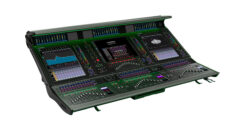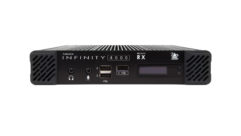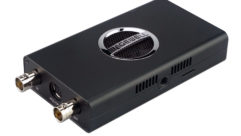
Technology Showcase: Video Format Converters
Jan 1, 2004 12:00 PM,
By David Riffle

A video format converter (VFC) is a utility tool designed toconvert video from one format to another. It is simple enough inconcept, but because video formats are intended for a multiplicity ofapplications and usually differ substantially from one another,performing an acceptable conversion is quite demanding. Video formatsdiffer in line and pixel count, frame aspect ratio, color space, signallevels and dynamic range, as well as in other aspects. A high-qualityVFC is expected to translate each signal parameter of one format intoan accurate representation of that parameter in another format.
WHY CONVERT?
However accurate and seamless this translation may be, each formathas its own display or transmission characteristics, and therefore anyvideo image will have a different appearance when it is converted toanother format. It will seldom look better as it is passed through aconversion, even if that conversion is perfect. That is because a videoimage is normally designed to look its best in its original format. Thebest that any conversion process can hope is to maintain the designappearance of the source video and not to introduce any picture orsignal degradation.
Why convert video signals then? A general rule is: don’t. Designyour graphics and video elements, shoot programs, edit, and obtainvideo material in the format you need. Usually, it is the displaymethod that will determine the format requirements, but many times itwill be the method of signal transport or the playback options at yourdisposal. Whichever it is, you should make a decision as to which willbe your video medium and keep all of your source and master material inthat format.
If you are fortunate enough to control the process of videoorigination, editing, distribution, and display, as well as theequipment involved in each step of this process, then you should havelittle difficulty selecting and maintaining the appropriate videoformat. This can be the case in a television studio environment, forexample. Usually, though, you will find that you have a variety ofvideo source material comprising several formats and that you need todistribute this material for use in a selection of formats or maybe toa selection of display types. When this is your situation, a VFC iswhat you will need.
WHAT ARE VIDEO FORMAT CONVERTERS?
Video format converters encompass a broad category of hardware andsoftware. This discussion will focus on hardware rather than software.Conversion from one format to another of greater resolution is referredto as up-conversion, and true up-converters perform just that:up-conversion. Devices that are intended to up-convert, cross-convert,and sometimes down-convert to a limited extent are known as videoscalers. The primary purpose of those devices is to adjust theformat characteristics of the video source material into the properformat needed to match the characteristics of a particular displaydevice. This article will discuss the aspect of video format conversionthat pertains to scaling source video for proper compatibility with aselected display.
With the proliferation of digital video signals and formats in thepast decade, especially during the past five years, the issue of videoand display resolution has become increasingly prominent. Analogsignals are inherently unlimited in resolution, having limits set onlyby the record and playback devices as well as the transmission anddisplay mediums. But digital signals contain finite units ofinformation, and digital video images can be mapped onto the screen ofa display device rather than “painted” onto the screen asis the case with analog signals. For this reason, it is important tomap every video source onto the screen in the same manner and to choosea single display format that matches the design parameters of thedisplay device. In doing that, you will ensure that your display is asgood as it can be. You must also ensure that the conversion of eachsource format to your chosen display format is as accurate as isreasonably possible.
DISPLAY BASICS
If you look first at the display devices available, there willbasically be two types: analog and digital. An example of an analogdevice is a CRT TV monitor, which has analog component or compositevideo inputs, or digital inputs, which will be converted to analogsignals internally. This type of monitor will process the input formatinto a form suitable to drive a CRT display, and then it will paint theimages on the screen in a mostly continuous manner. The CRT has a gridof phosphors across its screen that are illuminated to create thedisplayed images. The phosphors have a finite size and dimension andare not continuous, so in this way, they resemble a digital display.The number of phosphors on the CRT must be great enough to faithfullyrepresent the amount of detail in the source video, but there is notheoretical limit to their number beyond that point. The resolution ofthe video format itself is limited in the number of vertical scanlines, which will become more visible as the screen size is increased.An analog input is a smooth, continuous flow of information and can bepainted onto whatever size display is available.
In contrast, a digital signal has distinct units of image data and alimit to the amount of information in each data unit. A digital displayhas inputs for digital component or analog signals but then convertseach into a digital data stream suitable to be loaded into the displayscreen. This type of display can be thought of as sending video datadirectly to each pixel element, which is similar in function to eachphosphor in a CRT screen. Examples of digital displays are plasma andLCD monitors. The optimum image a digital display can produce willresult when the video aspect ratio matches the display screendimensions and when the input video signal can be mapped directly ontothe screen without any loss of data owing to an incompatible number ofscreen pixels and video data “pixels.” If a digital displayis presented with a video format that has a different frame aspectratio and pixel resolution, it will not be able to map the image pixelfor pixel and will produce a distorted display image, if any at all.Video scalers are designed to avoid this predicament by scaling thesource video format image in whichever direction required to match thedisplay screen resolution. This may involve some aspect ratioconversion and frame rate adjustments, but the end result will be animage that will display without distortion.
GENERALLY SPEAKING
In many applications such as boardroom or trade show presentations,the source video material will likely be an assortment of computergraphics, component video from various types of players, and videoplayed directly from computer sources. Each of these sources willlikely have different resolutions, video levels, and aspect ratios.Therefore, a video scaler that can take in each source, process andequalize the video levels, and then output a single resolution andformat that is matched to the pixel resolution and aspect ratio of theintended display is just what is needed. Ideally, that video scalerwould also be easy to configure, have a clear menu structure, have themost common type of connectors on its inputs and output, and possessthe capability for a wide range of input formats. If you want to applyit to different types of displays at other times, then it should alsopossess the capability for a wide range of output formats. It may alsoneed to transition between the sources rather than cut from one to theother, and it may need to store various configurations in memory.
Begin by determining whether your need is in a fixed applicationsuch as a home theater or a flexible application such as a trade showand then take an inventory of the source material, player formats,connector types on each, and especially the type of display you have,along with its display resolution and aspect ratio. If you have a fixedapplication, you can limit the input source compatibility range tothose that you currently have, and you can limit the output resolutionof the video scaler, as well. In this type of application, you probablywill not require the ability to transition between sources, but you mayneed to be able to process the source video levels. You will knowexactly which types of input and output connectors are needed. Makesome allowance, however, for expansion or for equipment replacements asnew technology manifests itself.
If your requirement is for a flexible application, then you mustcarefully consider the input and output format compatibility ranges andthe number of inputs and outputs that you expect to encounter. Sourcetransitions will probably be necessary, as well as aspect ratioadjustments. The video scaler will need to provide you with a lot offlexibility in an easy-to-manage user interface. This type is one ofthe universal scalers. Essentially, you may want to acquire avideo scaler with as many features as your budget will allow so thatyou will be ready for any contingency.
SPEAKING OF FEATURES
There are several features that video scalers can include that willhave a significant impact on the displayed image quality. Linedoubling, tripling, or quadrupling; deinterlacing and 3-2 pull-downremoval; and motion compensation and video processing have pronouncedeffects. Many video scalers are actually matrix video routers, but mostare multi-input, single- or dual-output video switchers. Usually youwill need audio to follow your video switching, and in the case of liveevent applications, you may need a mic source or a way to key a logoover the output. Depending on the display application, you may need torotate the image and sometimes display multiple images simultaneously.Remote control is important in many cases, and sometimes this will needto be done from a computer application rather than an IR controller. Itwill be important to consider whether you will want to store yourscaler configuration settings for later recall or for an interruptionin line power. Similarly, it may be necessary to upgrade the featureset on your scaler so that you can correct shortcomings or adjust tothe developments that new technology will bring. Each video scaler onthe market has some or all of these features, so just as with any othermajor equipment purchase, put a lot of thought into the evaluation ofyour expected application and future needs. In every case, reliabilityis essential.
You should evaluate your video scaler carefully and judge its outputsignal quality with a variety of video material displayed on the typeof monitor or projector you intend to use. Look at material withsharp-edged computer graphics, scrolling and rolling text, naturescenes with both rich and subtle colors, and scenes with sharp detail.Verify that all the source video formats you need are managed to yoursatisfaction and that you have all the adjustment range you feel isappropriate for your choice of output format, such as video processing,image zoom, and aspect ratio adjustments.
The manufacturer of your video scaler should be responsive, easy toreach, and ready to provide technical support if needed. Remember, thevideo scaler is what will make your source material look the way youintend, every bit as much as the display itself.
MANUFACTURER RESOURCES
Video scalers are available in three primary categories: hometheater, presentation, and staging and rental. There is some overlap,of course, but generally, a home theater will not require as muchflexibility from a video scaler, whereas a live event will probablyrequire as much as possible.
A small-scale, single-purpose scaler can be compact and finely tunedfor a limited number of source and output formats, and it does not needelaborate configuration interfaces. These devices include plug-inmodules for direct insertion into plasma displays and compactstandalone units that can be remotely switched from one input to thenext. Altinex, Analog Way, Communications Specialties, Extron, Folsom,Kramer, and RGB Spectrum market devices of this sort, most of whichscale analog composite, S-video, and component video inputs to analogcomponent HD video resolutions of 480p, 720p, or 1080i and VGA, SVGA,XGA, or SXGA resolutions, providing for video level and aspect ratiocontrol in the process. Remote control is included in many models.Aurora Multimedia makes four types of direct plug-in scaler cards forPioneer and Hitachi plasma monitors. The inputs to these cards includeDVI and output into the plasma at 720p or 1080i. The ASR-44 has apicture-in-picture (PiP) generator and audio-follow-video capability,and it can rotate, stretch, and crop multiple images at once. It alsofeatures significant video signal-processing controls, as well as audiopropagation delay control to keep the audio in sync with the video asit is processed. The X-Tune+ includes RF inputs, dual tuners, motioncompensation, and DVI connections. Key Digital Systems makes theKD-PIO768P direct plug-in card for the Pioneer plasma monitors, whichincludes DVI and SDI video signal inputs. Focus Enhancements’CenterStage line, the CS-1/2/HD, includes half-rack-size scalers thathave digital input and remote control and are compatible with Crestronand similar controllers. Silicon Optix markets the Image AnyPlace, ascaler that has sophisticated keystone correction circuitry, which canmanipulate the output for use with a projector display. Although thescaler is not limited to projector displays, this feature allows aprojector to be used at an angle of as much as 40 degrees horizontallyand 30 degrees vertically from the display surface. The Image AnyPlacecan correct for a number of optical distortions, including thoseproduced from the effects of surfaces that are curved or irregularlyshaped.
Slightly larger and with more inputs and format choices are thevideo scalers designed primarily for presentation applications. Thesescalers will often feature multiple outputs and are usually moreflexible in their ability to process images, especially when it isnecessary to control conversion artifacts. Among these are theuniversal video scalers. Astro Systems, Communications Specialties,Extron, Folsom, and RGB Spectrum each have high-performance videoscalers, well suited to presentation applications. Analog Way has theOCP-802, an 8-input, audio-follow-video with mic input universal scalerthat can input analog PAL, SECAM, and NTSC composite video, S-video,component, and RGB and VGA through SXGA signals. It also has twoboosted HD15 outputs scaled from 640 by 480 to 1280 by 1024, along withstereo audio. The TSC-550 and TSC-432 are similar, but less ofuniversal switcher/scalers. Aurora Multimedia’s DIDO has PiP, stretch,rotate, image crop, and audio-follow-video capability. The DIDO hasaudio propagation delay, motion adaptive image deinterlacing, andreadily upgradeable firmware capability. FSR has the MAS-4100A, whichis a 4-by-1 audio-follow-video switcher with an integrated scaler. Itis capable of scaling analog composite, component, and S-video touser-selectable output resolutions up to 1080i HD, and it includesremote control. Key Digital Systems has the KD-DH12, which includes adigital tuner and distribution amp with 12 separate outputs. TheKD-HD1080P is a digital in and out SD/HD video scaler/cross-converter.TV One makes the CSC-1600HD, a high-performance scaler capable ofanalog composite and component through HD 1080i input resolutions. Theoutput can be to HD15 or BNC connectors, and the unit provides fordeinterlacing, motion compensation, and signal-level adjustments. Ithas a variety of local and remote control possibilities, and like manyof this type, it uses an onscreen display menu for configuration. TheCSC-1100A is lower-cost model and has fewer features.
In the staging and rental category, several scalers are designed forthe particular needs of live event switching and scaling. These unitsare usually much larger than any in the previous categories, and theytypically include more inputs and multiple outputs. Often they add aseparate mic input and the means to key video source material. Altinex,Focus Enhancements, FSR, Folsom, and RGB Spectrum market devices inthis set. TV One’s C2-770, for example, is a universal switcher/scalerthat includes a frame synchronizer, TBC, aspect ratio converter, imagegenlock, PiP generator, chromakeyer, and lumakeyer.
THE MISSING LINK
Video scalers are a vital link between source video and digitaldisplay devices. In fact, any display larger than 38 inches is largeenough to benefit from the image enhancement tools that a video scalercan offer. But with digital displays like plasma and LCD monitors andnewer projection systems, the best display can be realized only if youcarefully match the resolution and aspect ratio of the source video tothe display characteristics. Many of the source video formats willbenefit from image processing during the up-conversion process, aswell. With the right video scaler, you will be very pleased with thedisplay results!
David Riffleis the CTO for Video Arts, a San Franciscovideo post-production facility. With more than 20 years experience inthe video industry, Riffle has worked in broadcast and post-production.He can be reached at[email protected].
For More Information
Altinex
www.altinex.com
Analog Way
www.analogway.com
Astro Systems
www.astro-systems.com
Aurora Multimedia
www.auroramultimedia.com
Communications Specialties
www.commspecial.com
Extron Electronics
www.extron.com
Focus Enhancements
www.focusinfo.com
Folsom Research
www.folsom.com
Key Digital Systems
www.keydigital.com
Kramer Electronics USA
www.kramerelectronics.com
RGB Spectrum
www.rgb.com
Silicon Optix
www.siliconoptix.com
TV One
www.tvone.com










